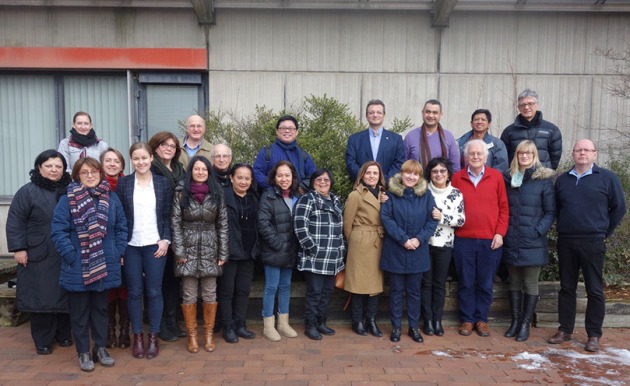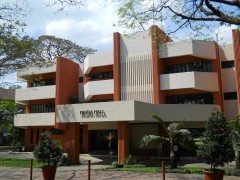Erasmus+ ARTIST project for science teaching innovation at AdMU: An interview with Mr. Ivan Culaba of the Physics Department
April 11, 2018 2 Comments

The ARTIST partners during the kick-off meeting at University of Bremen, Bremen, Germany on January 2017. In the photo are Dr. Joel Maquiling (back row, 3rd from the left) and Mr. Ivan Culaba (back row, 2nd from the right) of the Department of Physics, School of Science and Engineering, Ateneo de Manila University. Source: Action Research To Innovate Science Teaching (ARTIST)
Ateneo de Manila University and De La Salle University-Manila were chosen by the European Union’s Erasmus+ Program as its two partner universities in the Philippines for the ARTIST (Action Research To Innovate Science Teaching) project. The other eight partner universities are University of Bremen (Germany), Ilia State University (Georgia), Alpe-Adria-University (Austria), University of Limerick (Ireland), Gazi University (Turkey), Batumi Shota Rustaveli State University (Georgia), The Academic Arab College of Education (Israel), and Oranim Academic College of Education (Israel). The project coordinators are Prof. Dr. Ingo Eilks of the University of Bremen and Prof. Dr. Marika Kapanadze of Ilia State University.
The ARTIST project aims to innovate science education through classroom‐based and teacher‐driven Action Research–a cycle of innovation, research, reflection and improvement–by forming networks of higher education institutions, schools and industry partners in each partner country. The ARTIST project allows the partner universities to acquire state-of-the art audio-visual and science equipment for teacher trainings and instructions. Training materials on action research will be developed and used in workshops and courses.
Below is an interview with Mr. Ivan Culaba, manager of the ARTIST project in Ateneo de Manila University.
1. What is your role in the project? Are there other AdMU faculty involved here?
I am the manager of the ARTIST project in Ateneo. In the Department of Physics, Dr. Joel T. Maquiling and Ms. Johanna Mae M. Indias are also involved in the project. Joel has accompanied me in the meetings and helped in the presentations. Joel and Johanna helped in the identification of possible industry partners. Johanna also visited the high schools for evaluation as possible network partners. Ms. Via Lereinne B. Chuavon of the Office of Social Concern and Involvement assisted us in the networking with high schools and communications with the Schools Division Office of Marikina City. I also had very constructive discussions with Mr. Christopher Peabody of the Department of Chemistry. Mr. Tirso U. Raza, of the Office of Facilities and Sustainability has assisted us in finding the source of the audio visual equipment and in the preparation of the rooms for their installation. Our technicians, Mr, Numeriano Melaya, Mr. Colombo Enaje, Jr. and Mr. Ruel Agas have been working on making the ADMU ARTIST Network Center and Physics Education Resource Center (F-230, Faura Hall) become functional.

Action Research for the Reflective Practitioner workshop at Ateneo de Manila University, 7 April 2017
3. How did you get involved in the project?
This project was conceived by Prof. Eilks and Prof. Kapanadze after their successful implementation of TEMPUS project SALiS. I met Prof. Kanapadze during the Active Learning in Optics and Photonics workshop at Ilia State University, Tbilisi, Georgia in 2014, where she was the organizer. She invited me into the ARTIST project and I extended the same invitation to Dr. Lydia Roleda of the De La Salle University-Manila.
I became interested in the ARTIST project since we had just started with the NSTP activity wherein our Physics majors were assigned to Sta. Elena High School for the area engagements. While our students were facilitating in the high school students’ physics activities we were also engaged in the Physics training of the science teachers in the same school. We thought that the high schools would immensely benefit from the ARTIST project in line with the university’s thrust for greater social involvement and service learning.
The ARTIST project was approved by the EU commission on October 2016 but the first tranche of the budget was released on January 2017.
4. What were your ARTIST meetings in Europe all about?
The kick-off meeting was held at the University of Bremen, Bremen, Germany on 18-20 January 2017. It was the first time that we met our collaborators in the project. The objectives of the project, deliverables, work plans, and financial management among other topics were discussed. The second meeting was held at the Alpen-Adria-Universität Klagenfurt, Vienna, Austria on 14-15 September 2017. Progress reports on the networking with schools and industries, financial status of each partner university, scheduling of the workshops, planning of the e-journal ARISE and other matters were discussed in the meeting. The EU officials were not present in the meeting.

Physics Education Resource Center (PERC) and ARTIST Network office Room F-230, Faura Hall
5. How is the Physics Education Resource Center in Faura Hall?
I am very happy that we now have a Physics Education Resource Center (PERC) where the Physics Education group can meet and hold meetings and where the valuable lecture demonstration experiment set-ups can be displayed and made accessible to the faculty of the Department. A number of the demos have been transferred from F-229 and SEC C labs to PERC. Acquisition and development of lecture demonstration experiments will be a continuing process. The next step is the documentation of the resources so that the faculty may know what demos are available and how to use them.
The room will also serve as the office of the ARTIST project. The science equipment which will be purchased under this project will be placed in this room. We have ordered Physics equipment which are aligned to the Physics topics in Grades 7-10, although they may also be used for senior high school Physics. The list covers mechanics, heat and thermodynamics, waves and sound, optics and electromagnetism. There will also be materials which will be locally fabricated like ticker taper timers, circuit boards and Plexiglass lenses.
6. What are upcoming activities of the ARTIST project for this year?
We have held two seminar-workshops on Action Research. The first one was held on August last year in Ateneo de Manila. Prof. Maricar S. Prudente, who is an expert in Action Research, was the main speaker. The facilitators were Dr. Lydia S. Roleda, Dr. Minie Rose C. Lapinid and Dr. Socorro C. Aguja. They are all from the Science Department, Bro. Andrew Gonzales, FSC College of Education, De La Salle University. There were about ten participants from Roosevelt College, Inc. and some graduate students.
The second seminar-workshop was held recently on 7 April 2018 at Faura Hall, Ateneo de Manila. It was organized by the ARTIST team of Ateneo and De La Salle. The same team of speaker and facilitators from De La Salle University ran the seminar-workshop. A total of 31 participants from the ARTIST network of high schools – Parang High School, Sta. Elena High School, Marikina High School, Colegio de San Agustin, and graduate students in MS Science Education attended the workshop.
Another workshop on Action Research will be held on 15-18 May 2018 at De La Salle University-Manila. The ARTIST partners from Germany, Ireland, Austria, Georgia and Israel will facilitate the workshop. The first three days will be spent on understanding AR and writing AR proposals by selected teacher-participants. There will be an AR symposium, open to other teachers, on the fourth day where AR case studies will be presented.
Come October 2018 the workshop on Action Research and a meeting of the collaborators will be held in Haifa, Israel.
7. Any parting thoughts?
We hope that this project will have a positive impact on the way science is taught in the partner high schools and the lessons learned from these experiences may be adapted by other schools in the country.

Participants of Action Research for the Reflective Practitioner workshop at Ateneo de Manila University, 4 August 2017





















